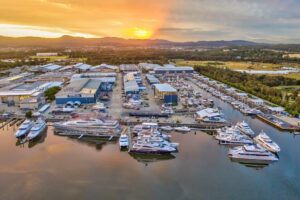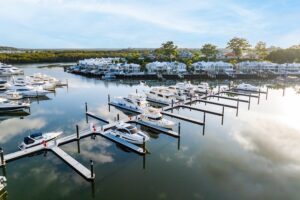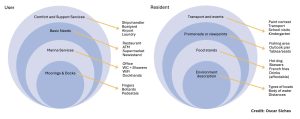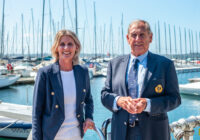By John Hogan, Director, Marine Structures
Sustainability is a topic that we all touch on in our daily lives. Our marina industry in Australia and New Zealand already has a commitment to these principles as demonstrated in the Clean Marina Program and other initiatives such as Climate Ready.

Gold Coast City Marina & Shipyard
In the text, Sustainable Marina Development I published over a decade ago, the use of four instead of the normal three aspects of Sustainability was proposed. The commonly used definition of Sustainability means consideration of Environmental, Economic and Social factors; however, I believe we need to add Destination Protection as a major consideration. Given that many industry professionals have access to the management tools to implement such measures at the grass roots level, this article focusses on practical applications, rather than large, capital intensive projects.
DESTINATION PROTECTION
Marina owners and operators are naturally motivated to protect their investment for the longevity of their business, however it is only by passing on this passion to all stakeholders that a site becomes special. The secret to this lies within the base design philosophy whereby it is known that many can copy you, however no one can be YOU, if you clearly think and articulate your vision, values and mission.
Therefore, a recreational marina may prioritise the tenants onshore and their customers to create a vibe whereby the boat owners are proud to “see and be seen” in this locality. “Keep the big boats close to the till” as Keith Williams used to say, becomes a design and management priority if we are thinking how we wish the site to operate long after the installation contractors have left. Advanced rendering software can give a lifelike indication of the amenity of the built infrastructure.
Destination protection can include ‘Fish Friendly’ and ‘Clean Marina’ programs, it can incorporate shared water quality stats and active habitat improvement. Many school programs visit marinas for lessons in ecology, marine science, sailing and general exposure to our land sea connection. These programs along with the love of beaches and swimming has forged thousands of people who love this environment, and it is the reason why over 25% of the superyacht crews worldwide are Kiwis and Aussies.
With so many opportunities to protect your destination as a special business in a special location, these ideas to make your own Unique Value Proposition are the key to your strategic planning for the future.
The Australian marina industry is actively embracing sustainability through various initiatives aimed at economic viability, environmental conservation and community engagement. The MIA’s Marine Sustainability Pledge is a great example of this.
ECONOMIC considerations are always the first and foremost in most organisations, however these days enlightened managers will know that if people are the focus with sound budgets, then this aspect can be effectively delivered. Maintaining an eye for change as the marketplace changes is a key role for management. An example was a manager who assessed that the berths under 10m that were a fixture in the marina, were no longer providing an adequate yield. Once this space was allocated to jetski docks for tenders and skis, the economic benefits flowed quickly.
Further, a low-maintenance pontoon system in a marina isn’t just about convenience – it’s a smart, long-term investment. With durable, weather-resistant materials and minimal upkeep requirements, marina operators can save time and money on repairs while ensuring a reliable docking solution for years to come. Plus, a well-designed system improves safety, enhances the overall look of the marina, and provides a better experience for boaters. I have witnessed first-hand that over time, these benefits add up, reducing operational costs and increasing the marina’s value.
A final economic factor to mention is energy. An energy efficient marina isn’t just good for the environment – it’s also great for keeping costs down. By using high-capacity batteries to store energy, marinas can take advantage of off-peak electricity rates, reducing overall power expenses. Solar panels and wind turbines can further supplement energy needs, cutting reliance on the grid and making operations more sustainable. Plus, brokered power deals allow the marina to secure the best energy rates, ensuring predictable costs and long-term savings. With a smart mix of green energy and strategic power management, the marina stays efficient, cost-effective, and environmentally friendly. A further option here is to leverage government programs supporting renewable energy or environmental conservation.

Sanctuary Cove Marina
ENVIRONMENTAL is the aspect most often thought of, as the overriding part of Sustainability. While the climate change debate has grown significantly in the past 50 years, I can remember visionary leaders prior to this promoting sound environment principles long before they became in vogue. If there is a possibility to reuse a resource, from the humble water bottle to piles, pontoons, timber and countless others, then we should actively seek out these opportunities. This is a reason why our industry has become expert at repurposing brown field sites into viable vibrant marina locations.
Environmentally friendly mooring systems have also come a long way over the years and are now becoming the go-to choice for marinas worldwide. While traditional mooring methods can damage fragile seabeds and marine ecosystems, elastic mooring lines are a reliable alternative that are quickly becoming a preferred option.
Electric boats are also making a big splash in the push for more sustainable marinas as they produce zero emissions, meaning cleaner air and healthier waterways. They’re also much quieter, reducing noise pollution that can disturb marine life. Plus, with advancements in battery technology and solar charging options, electric boats are becoming more efficient and practical for everyday use. Marinas that embrace this shift not only lower their environmental impact but also attract eco-conscious boaters looking for greener ways to enjoy the water. It’s a win-win for both boaters and the environment!

SOCIAL is my this endeavour. The graphic by Oscar Siches of the relationship between people onshore and people on boats is the key to understanding this dynamic. It is not sufficient to only consider what the paying customer desires, as this only provides a limited sealed-off facility that lacks the joie de vivre, the simple interaction between all of the stakeholders.
Marinas are all about connection—between people, places, and the water. They’re natural gathering spots where locals and traveling boaters meet, swap stories, share resources, and build a sense of community. It’s a relationship built on curiosity, mutual support, and a love for the sea. As marinas continue to embrace sustainable tourism, inclusive planning, and eco-friendly boating, these connections will only get stronger. More than just docking spots, marinas are evolving into vibrant hubs where land and sea life come together in a way that benefits everyone.
Let’s also look at the connection between coffee shops, dogs, and marinas – they always seem to go together to create exciting, community-focused spaces that foster interaction, relaxation, and shared experiences. This combination caters to a lifestyle centred on enjoyment, outdoor activity, and companionship.
In closing, the marina environment is ripe for Sustainability options that balance environmental stewardship, economic growth, and community engagement. Australia’s marina industry is already leading the way with initiatives like the Marine Sustainability Pledge, Clean Marina Program, habitat restoration and eco-education efforts. By using renewable energy, encouraging green boating, and fostering cultural collaboration, marinas are proving that sustainability isn’t just a nice idea—it’s essential for preserving Australia’s incredible marine ecosystems.
With the right mix of government support, association leadership and guidance, industry standards, and community involvement, marinas can help protect our waters while also creating exciting opportunities for local businesses. The marina of the future is not just a place for recreation and mooring boats – it is a model for how humans and nature can coexist harmoniously. By embracing these options now, we can ensure that Australia’s iconic coastal and marine environments remain vibrant and thriving for generations to come.

John Hogan is the Director of Marine Structures, a company formed through the merger of Superior Jetties and The Jetty Specialist Groups. Headquartered in Southeast Queensland, Marine Structures has become Australia’s leading provider of marina infrastructure. With manufacturing facilities on both the Sunshine Coast and the Gold Coast, the company has been serving the market for over 35 years, producing and installing a wide range of marine berthing systems across Australia and exporting through an international dealer network.
John served as Chairman of the Global Marina Institute from 2016 to 2019 and has been a Board Member of the Marina Industries Association since 2004.
This story originally appeared in the Marine Industries Association Waterline Magazine and has been reproduced with their permission.







